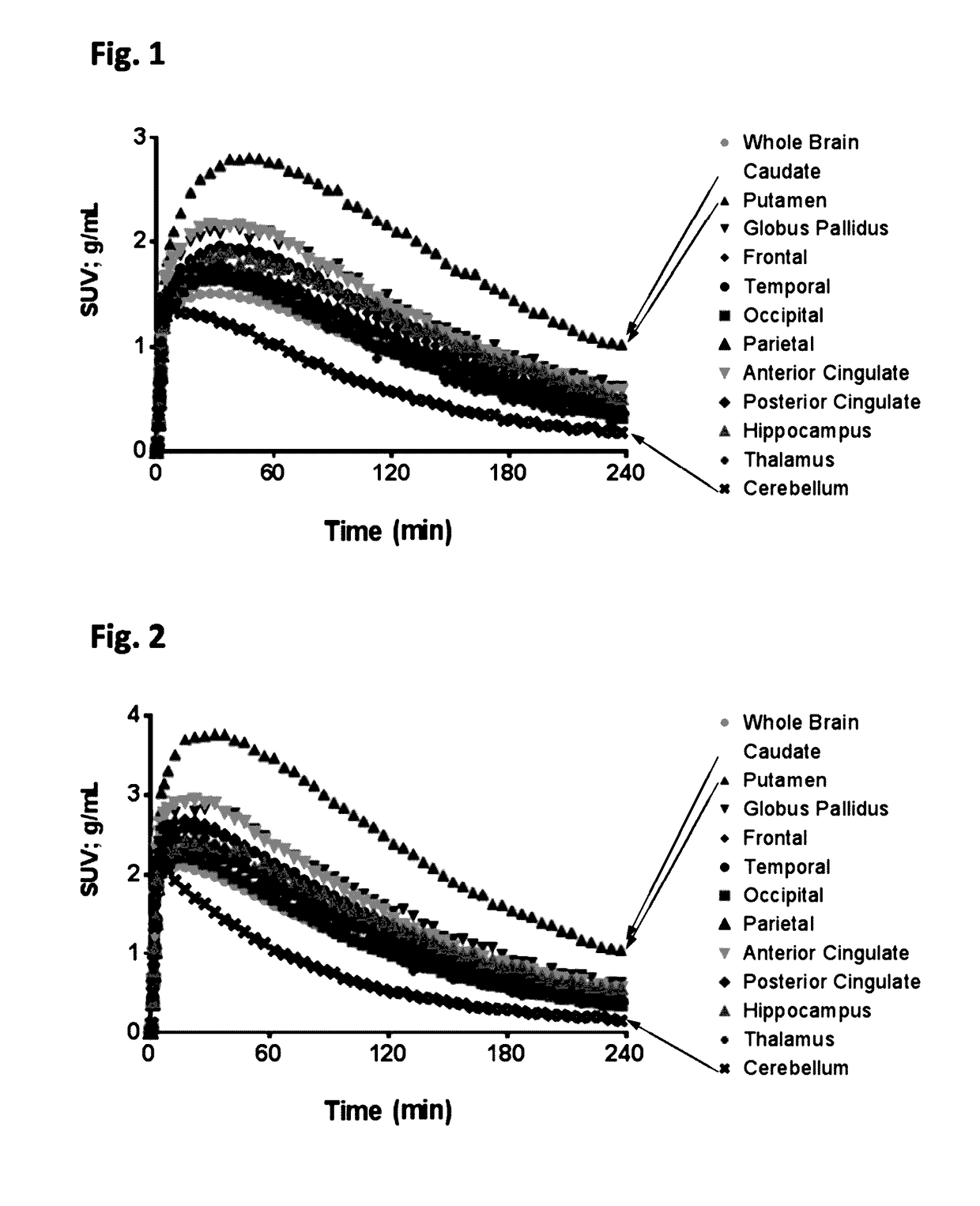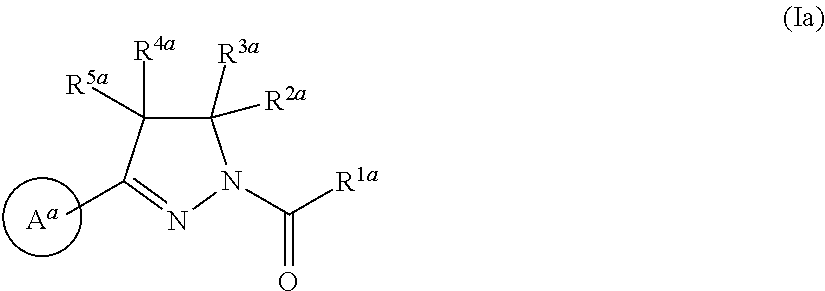Radiolabeled compounds
a technology of radiolabeled compounds and compounds, applied in the field of radiolabeled compounds, can solve the problems of limiting their use, increasing the number of patients with alzheimer's disease, and inability to obtain much of this information by other means
- Summary
- Abstract
- Description
- Claims
- Application Information
AI Technical Summary
Benefits of technology
Problems solved by technology
Method used
Image
Examples
reference example 1
N-cyclopropyl-1-(4-(4-fluorophenyl)pyrimidin-5-yl)-N-methylpiperidine-4-carboxamide
A) ethyl 1-(2-(4-fluorophenyl)-2-oxoethyl)piperidine-4-carboxylate
[0484]To a mixture of ethyl piperidine-4-carboxylate (8.0 g) and potassium carbonate (9.6 g) in acetonitrile (90 mL) was added dropwise 2-chloro-1-(4-fluorophenyl)ethanone (8.0 g) in acetonitrile (60 mL) at room temperature. The mixture was stirred at the same temperature overnight. The reaction mixture was concentrated in vacuo, diluted with water and extracted with ethyl acetate. The extract was washed with brine, dried over sodium sulfate, filtered and concentrated in vacuo to give the title compound (13 g).
[0485]MS (API+), found: 294.1.
B) ethyl 1-(4-(4-fluorophenyl)pyrimidin-5-yl)piperidine-4-carboxylate
[0486]A mixture of ethyl 1-(2-(4-fluorophenyl)-2-oxoethyl)piperidine-4-carboxylate (13 g) and DMF-DMA (82 mL) was refluxed overnight. The mixture was concentrated in vacuo. The mixture was dissolved into n-butanol (40 mL) and DIPEA (...
reference example 2
(3-fluoroazetidin-1-yl) (1-(4-(4-fluorophenyl)pyrimidin-5-yl)piperidin-4-yl)methanone
[0491]A mixture of 1-(4-(4-fluorophenyl)pyrimidin-5-yl)piperidine-4-carboxylic acid (0.10 g), 3-fluoroazetidine hydrochloride (0.056 g), HATU (0.16 g), DIPEA (0.23 mL) and DMF (2.0 mL) was stirred at room temperature for 18 hr. The mixture was diluted with ethyl acetate and water, and extracted with ethyl acetate. The organic layer was washed with water and brine, dried over anhydrous sodium sulfate, and the solvent was evaporated under reduced pressure. The residue was purified by silica gel column chromatography (NH, ethyl acetate / hexane), and triturated with diethyl ether to give the title compound (0.11 g).
[0492]1H NMR (300 MHz, CDCl3) δ 1.62-1.94 (4H, m), 2.18-2.31 (1H, m), 2.59-2.73 (2H, m), 3.21-3.34 (2H, m), 4.03-4.49 (4H, m), 5.18-5.46 (1H, m), 7.12-7.21 (2H, m), 8.09-8.17 (2H, m), 8.41 (1H, s), 8.90 (1H, s).
reference example 3
1-(4-(4-chloro-1H-pyrazol-1-yl)pyridin-3-yl)-N-methyl-N-(tetrahydro-2H-pyran-4-yl)piperidine-4-carboxamide
A) 4-(4-chloro-1H-pyrazol-1-yl)-3-fluoropyridine
[0493]A mixture of p-toluenesulfonic acid monohydrate (0.58 g), 4-chloro-3-fluoropyridine (2.0 g), 4-chloro-1H-pyrazole (1.7 g) and 2-propanol (10 mL) was irradiated with microwave at 130° C. for 2 hr. The mixture was allowed to be cooled to room temperature, saturated aqueous sodium bicarbonate solution was added thereto, and the mixture was extracted with ethyl acetate. The organic layer was washed with saturated brine, and dried over anhydrous sodium sulfate, and the solvent was evaporated under reduced pressure. The residue was purified by silica gel column chromatography (ethyl acetate / hexane) to give the title compound (2.2 g).
[0494]MS (API+), found: 198.2, 200.0.
B) ethyl 1-(4-(4-chloro-1H-pyrazol-1-yl)pyridin-3-yl)piperidine-4-carboxylate
[0495]A mixture of 4-(4-chloro-1H-pyrazol-1-yl)-3-fluoropyridine (3.4 g), ethyl piperidi...
PUM
| Property | Measurement | Unit |
|---|---|---|
| Electric charge | aaaaa | aaaaa |
| Capacitance | aaaaa | aaaaa |
| Capacitance | aaaaa | aaaaa |
Abstract
Description
Claims
Application Information
 Login to View More
Login to View More - R&D
- Intellectual Property
- Life Sciences
- Materials
- Tech Scout
- Unparalleled Data Quality
- Higher Quality Content
- 60% Fewer Hallucinations
Browse by: Latest US Patents, China's latest patents, Technical Efficacy Thesaurus, Application Domain, Technology Topic, Popular Technical Reports.
© 2025 PatSnap. All rights reserved.Legal|Privacy policy|Modern Slavery Act Transparency Statement|Sitemap|About US| Contact US: help@patsnap.com



